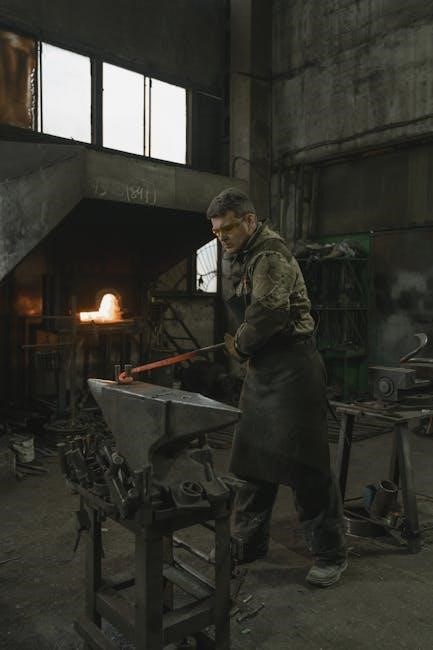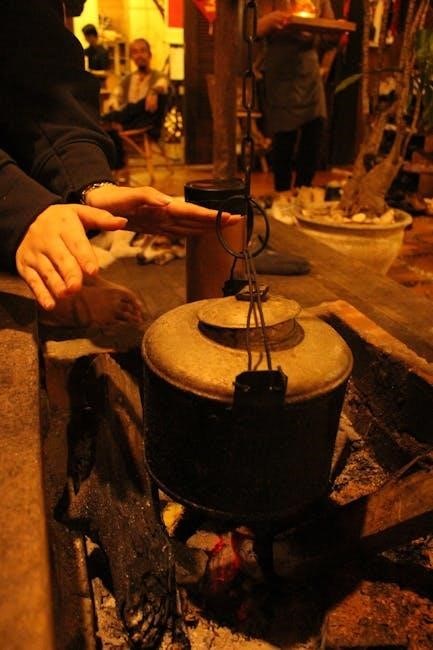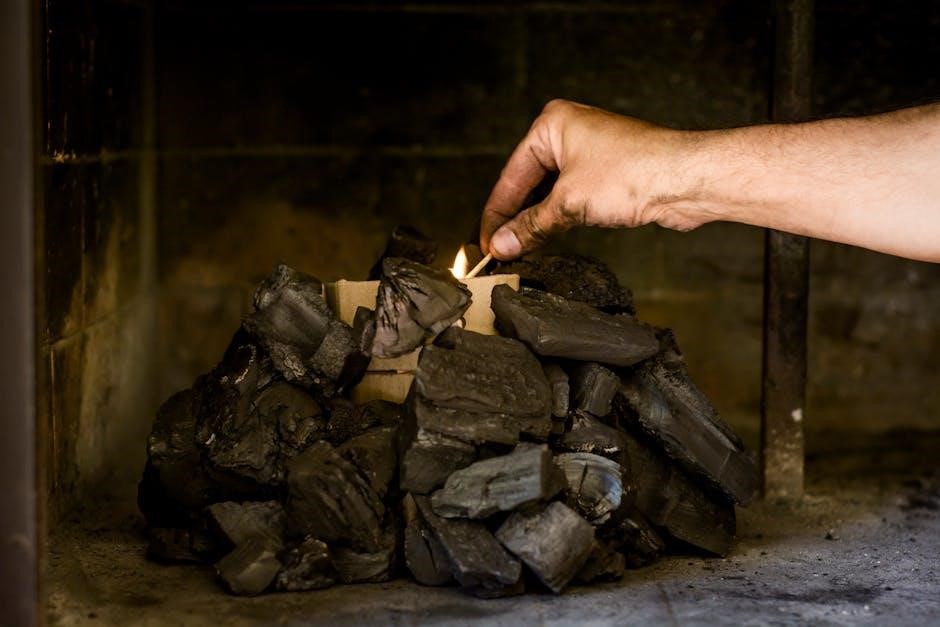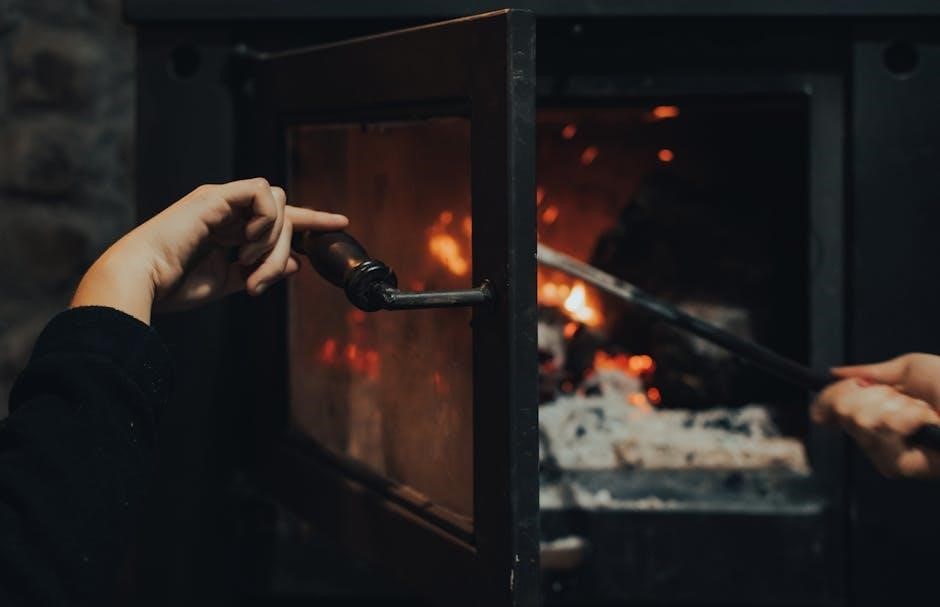This manual provides essential guidance for safe and efficient operation of your Heatilator gas fireplace, covering installation, maintenance, and troubleshooting to ensure optimal performance and safety.
Overview of the Heatilator Gas Fireplace
The Heatilator gas fireplace is a reliable and efficient appliance designed to provide warmth and ambiance to your home. Available in various models, including B-Vent and Direct Vent options, it ensures safe combustion and optimal performance. The Direct Vent system vents gases outside while drawing fresh air for combustion, maintaining indoor air quality. B-Vent models are designed for simplicity and versatility. These fireplaces are built with durable materials and advanced features to enhance safety, reliability, and energy efficiency. Whether you choose the GBST36 Series, ND3933, or GNDC36, Heatilator fireplaces offer a seamless blend of functionality and aesthetic appeal, making them a popular choice for homeowners seeking a cozy and modern heating solution.
Importance of Reading the User Manual
Reading the Heatilator gas fireplace user manual is crucial for ensuring safe, efficient, and proper operation of your appliance. It provides detailed instructions for installation, maintenance, and troubleshooting, helping you avoid potential hazards. The manual outlines safety guidelines, operating procedures, and model-specific features, ensuring compliance with local codes and standards. By following the manual, you can maximize the performance and longevity of your fireplace while minimizing energy consumption. It also serves as a quick reference for resolving common issues and understanding diagnostic codes. Always consult the manual before performing any adjustments or repairs to ensure your Heatilator gas fireplace operates safely and efficiently.

Safety Guidelines and Precautions
Always adhere to safety guidelines to ensure proper operation and prevent hazards. Follow local codes, National Fuel Gas Code, and manufacturer instructions for installation and maintenance. Ensure proper venting to maintain air quality and efficiency. Conduct regular safety checks and address any issues promptly to guarantee safe and reliable performance. Never ignore safety precautions outlined in the manual.
General Safety Information
Your Heatilator gas fireplace is designed for safety and reliability, but proper precautions are essential. Always read this manual carefully to understand safety features and operating guidelines. Ensure the appliance is installed by a qualified technician in compliance with local codes and standards, such as the National Fuel Gas Code or CSA B149.1. Proper ventilation is critical to prevent hazards like carbon monoxide buildup. Never operate the fireplace if it is damaged or malfunctioning. Keep flammable materials away and ensure children and pets are supervised near the unit. Regular maintenance and inspections are vital to maintain safety and performance. Follow all manufacturer recommendations to avoid potential risks and ensure a safe, enjoyable experience.
Pre-Installation Safety Checks
Before installing your Heatilator gas fireplace, conduct thorough safety checks to ensure a safe and proper setup. Verify that the installation location meets all local building codes and regulations, including proper ventilation requirements. Ensure the area is clear of flammable materials and obstructions. Check the gas line for leaks and ensure it is rated for the fireplace’s specifications. Confirm that the chimney or venting system is compatible with the unit and free from blockages. Inspect the surrounding area for proper clearances from combustible materials, as specified in the manual. Ensure all electrical connections are secure and meet safety standards. A qualified technician should perform these checks to guarantee compliance and safety.
Operating Safety Tips
Always follow essential safety practices when operating your Heatilator gas fireplace. Ensure the fireplace is turned off when not in use, especially during extended periods. Keep the surrounding area clear of flammable materials, such as curtains or rugs. Never leave children or pets unattended near the fireplace. Regularly inspect the glass and vents for cleanliness and damage. Avoid operating the fireplace if you detect unusual odors or sounds. Ensure proper ventilation to prevent carbon monoxide buildup. Never use the fireplace as a primary heat source unless specified. Keep the remote control out of reach of children. Remember to turn off the gas supply if you suspect a malfunction. Always follow the manufacturer’s guidelines for safe operation.

Installation Requirements and Recommendations
Ensure compliance with local building codes and regulations. Proper ventilation is essential for safe operation. Maintain clearance from combustible materials as specified. Install on a level surface for optimal performance.
Understanding Local Codes and Regulations
Adherence to local building codes and fire safety standards is crucial for the safe installation and operation of your Heatilator gas fireplace. These regulations vary by location and may include specific requirements for venting, clearances, and electrical connections. Always consult your local authorities to ensure compliance. Failure to meet these codes can result in safety hazards or legal issues. Additionally, verify that your installation meets the National Fire Protection Association (NFPA) standards and any other applicable regional guidelines. Proper permits and inspections are typically required before and after installation. This ensures your fireplace is installed correctly and safely, providing peace of mind for years to come.
Choosing the Right Venting System
Selecting the appropriate venting system for your Heatilator gas fireplace is essential for safe and efficient operation. The primary options are direct vent and natural vent systems. Direct vent fireplaces use a sealed combustion chamber and vent directly outside, requiring minimal installation and offering high efficiency. Natural vent systems rely on chimney draft and are typically less expensive but may require a taller chimney. Consider factors like your home’s construction, local climate, and venting location when making your choice. Proper venting ensures safe removal of combustion byproducts and maintains indoor air quality. Always follow manufacturer guidelines and local regulations for installation. Professional advice is recommended to make the best choice for your setup.
Installation Steps for Direct Vent Gas Fireplaces
Installing a Heatilator direct vent gas fireplace requires careful planning and adherence to safety guidelines. Begin by planning the venting route, ensuring it meets local codes and manufacturer specifications. Install the venting components, including the termination kit and vent pipes, ensuring proper sealing to prevent gas leaks. Connect the gas line to the fireplace, turning off the supply before starting work. Mount the fireplace in a sturdy location, ensuring it is level and secure. Install any additional components, such as a wall receptor, and connect the venting system to the fireplace. Finally, test the system by lighting the pilot and checking for proper venting. Always follow the manufacturer’s instructions and consider hiring a certified professional for a safe and correct installation.

Understanding the Components of Your Heatilator Gas Fireplace
Your Heatilator gas fireplace consists of a burner, logs, venting system, control panel, and ignition system. These components work together to provide safe and efficient heat.
Key Parts and Their Functions
Your Heatilator gas fireplace features essential components designed for safe and efficient operation. The burner produces the flame, while the heat exchanger transfers warmth into the room. The venting system ensures proper airflow and exhaust. The ignition system, including the pilot light or electronic ignition, lights the burner. The control panel allows adjustment of settings like flame height and heat output. Ceramic logs mimic real wood for a realistic appearance. The remote control or wall switch provides convenient operation. Understanding these parts helps you operate and maintain your fireplace effectively.
Gas Control System Overview
The gas control system is a critical component of your Heatilator gas fireplace, responsible for regulating gas flow and ensuring safe operation. It includes a gas valve that controls the flow of fuel to the burner, a safety sensor to monitor flame presence, and an ignition module for electronic ignition systems. This system also features an automatic shutoff mechanism that stops gas flow if a malfunction or interrupted flame is detected. The control system ensures precise flame height adjustment and maintains optimal performance. Regular inspection and maintenance of this system are vital for safety and efficiency, as outlined in the manual.
Venting System Components
Your Heatilator gas fireplace features a venting system designed to safely direct combustion byproducts outside. The system includes a vent pipe, which connects the fireplace to the exterior, and a termination cap to prevent debris and pests from entering. The elbow fittings allow for flexible installation around obstacles. The venting system is crucial for maintaining airflow and ensuring efficient operation. Proper installation and alignment are essential to prevent blockages and ensure safe venting. Regular inspection of these components is recommended to avoid damage or corrosion. The venting system is a key part of your fireplace’s functionality, ensuring safe and efficient performance while protecting your home from harmful fumes.

Operating Your Heatilator Gas Fireplace
Learn to safely ignite, adjust flame height, and monitor heat output for optimal performance. Follow daily operation tips to ensure efficiency and longevity of your fireplace.
Ignition and Start-Up Procedures
To safely ignite your Heatilator gas fireplace, ensure the area is clear of flammable materials. Locate the control knob, typically found below the fireplace or on the side. Turn the knob to the “pilot” position and press it in while lighting the pilot light with a match or lighter. Once the pilot is lit, release the knob and turn it to the “on” position to ignite the main burner. Always follow the manufacturer’s instructions for ignition. If the pilot light does not stay lit, check for proper gas flow and ventilation. Monitor the fireplace during start-up to ensure it operates smoothly and safely.
Adjusting Flame Height and Heat Output
To adjust the flame height and heat output on your Heatilator gas fireplace, locate the control valve, usually found near the base or on the side. Turn the valve clockwise to reduce the flame height and heat output or counterclockwise to increase it. For precise adjustments, some models feature a remote control or wall switch. Always ensure proper ventilation when altering the flame size. A higher flame may produce more heat but also increase gas consumption. For optimal performance, monitor the flame color; it should be blue for proper combustion. Adjustments should be made cautiously to avoid extreme temperatures or inefficient burning. Regular maintenance ensures smooth control operation.
Daily Operation and Maintenance Tips
For optimal performance and longevity, follow these daily operation and maintenance tips for your Heatilator gas fireplace. Always ensure the area around the fireplace is clear of flammable materials. Before use, inspect the glass for dirt or dust and clean it with a soft cloth and mild soap solution. Check the venting system regularly to ensure proper airflow and no blockages. After each use, allow the fireplace to cool completely before cleaning. Use a vacuum or brush to remove ash or debris from the firebox. Never leave the fireplace unattended while in operation. Regularly check the pilot light for a steady blue flame, indicating proper function. Schedule professional servicing annually to maintain efficiency and safety.

Troubleshooting Common Issues
Identify and address common issues with your Heatilator gas fireplace, such as ignition difficulties, error codes, or uneven flames. Consult the diagnostic guide in your manual for solutions. If issues persist, contact a certified technician.
Identifying and Solving Common Problems
Common issues with your Heatilator gas fireplace may include ignition failure, low flame output, or error codes. Start by checking the pilot light and ensuring the gas supply is open. If the flame is uneven, inspect the burner orifice for blockages and clean it if necessary. For error codes, refer to the diagnostic chart in your manual to identify the issue. Ensure the venting system is clear and functioning properly. If problems persist, consult the troubleshooting section or contact a certified technician. Regular maintenance can help prevent many of these issues, ensuring safe and efficient operation of your fireplace.
Understanding Diagnostic Codes
Your Heatilator gas fireplace may display diagnostic codes to indicate specific issues. These codes, such as “E1” or “E3,” are designed to help identify malfunctions quickly. Refer to the manual’s diagnostic chart to interpret the meaning of each code. Codes often relate to issues like ignition failures, gas valve problems, or venting system errors. Always address these codes promptly to ensure safe operation. For example, an “E1” code may indicate a pilot light issue, while an “E3” could signal a venting obstruction. Use the manual’s guidance to resolve the problem or contact a certified technician if necessary. Accurate code interpretation ensures efficient troubleshooting and maintains fireplace performance.
Resetting the Fireplace After a Power Outage
After a power outage, your Heatilator gas fireplace may require resetting to resume operation. Start by waiting a few minutes after power is restored to ensure all components are ready. Locate the reset button, typically found on the control panel or behind the fireplace. Press and hold the reset button for about 10 seconds until the pilot light ignites. If the fireplace does not restart, repeat the process. If it still fails to function, check for any blockages or issues with the gas supply. Avoid forcing the reset button, as this could damage the system. If problems persist, contact a certified technician for assistance. Always prioritize safety when resetting your fireplace after a power outage.

Maintenance and Servicing
Regular maintenance ensures optimal performance and safety. Clean the fireplace, inspect components, and schedule annual professional servicing. Address any wear or tear promptly to maintain efficiency and reliability.
Cleaning the Fireplace and Components
Cleaning is essential for maintaining efficiency and safety. Start by turning off the fireplace and allowing it to cool completely. Use a soft cloth to wipe down the exterior, avoiding harsh chemicals. For the glass, apply a mild glass cleaner and rinse thoroughly. Inspect the burner and logs for soot or debris, cleaning them gently with a brush or vacuum. Regularly check the venting system for blockages. Clean or replace filters as needed. Always refer to the manufacturer’s instructions for specific cleaning products and methods. Proper maintenance ensures optimal performance and longevity of your Heatilator gas fireplace. Schedule professional cleaning annually for thorough servicing.
Annual Servicing Requirements
Annual servicing is crucial to ensure your Heatilator gas fireplace operates safely and efficiently. Hire a qualified technician to inspect the venting system, burner, and ignition components. They will check for wear, damage, or blockages and clean or replace parts as needed. The technician will also verify proper gas flow and ensure all safety features are functioning correctly. Heatilator recommends servicing before the heating season to prepare for consistent use. Additionally, check for any updates or recalls. Regular servicing helps prevent malfunctions, maintains warranty validity, and ensures compliance with safety standards. Schedule your annual service to enjoy reliable performance and peace of mind.
Replacing Parts and Accessories
Replacing parts and accessories for your Heatilator gas fireplace is essential for maintaining performance and safety. Always use genuine Heatilator parts to ensure compatibility and reliability. Common replacements include igniter electrodes, ceramic logs, and venting components. Inspect parts regularly for wear or damage and replace them immediately if issues are found. For complex replacements, such as the gas valve or burner, consult a qualified technician to avoid safety risks. Accessories like remote controls or blower kits can enhance functionality. Refer to the Heatilator parts catalog or contact authorized dealers for genuine replacements. Proper installation ensures your fireplace operates safely and efficiently, adhering to manufacturer guidelines and warranty conditions.

Venting System Maintenance
Regular venting system maintenance is crucial for safe and efficient operation. Inspect for blockages, damage, or corrosion, and clean as needed to ensure proper airflow and safety.
Inspecting and Cleaning the Venting System
Regular inspection of the venting system is essential to ensure safe and efficient operation. Start by visually examining the venting components for blockages, such as debris, soot, or animal nests. Check for signs of damage, corrosion, or wear on the vent pipes and connections. Use a flashlight to inspect internal sections if accessible. Clean the venting system annually or as needed, using a soft brush or vacuum cleaner to remove dust and soot buildup. For stubborn residue, a mild detergent solution may be applied, but avoid harsh chemicals that could damage the materials. Always turn off the fireplace and allow it to cool before performing any cleaning.
After cleaning, ensure all vents are securely reconnected. If you notice significant damage or corrosion, contact a qualified technician for repairs. Regular maintenance helps prevent carbon monoxide leaks and ensures proper airflow, which is critical for both safety and performance. For optimal results, consider scheduling an annual inspection by a professional to identify potential issues early. This proactive approach not only extends the lifespan of your system but also guarantees reliable operation during colder months.
Ensuring Proper Ventilation
Proper ventilation is critical for the safe and efficient operation of your Heatilator gas fireplace. Always ensure that the room is well-ventilated to prevent the accumulation of combustion byproducts. Open windows or use fans to maintain airflow, especially during extended use. Regularly inspect the venting system for blockages, such as debris or nests, which can obstruct airflow. Clean or replace vent filters as recommended to maintain optimal performance. Additionally, install carbon monoxide detectors in your home to monitor air quality. Proper ventilation not only enhances safety but also improves the overall efficiency of your fireplace, ensuring a warm and comfortable experience. Routine checks and maintenance will help prevent potential hazards and keep your system running smoothly.

Warranty and Support Information
Heatilator provides a limited warranty covering parts and labor for up to 10 years. Register your product online or through an authorized dealer. For more details, refer to the manual or visit Heatilator’s website. Contact customer support for assistance with warranty claims, repairs, or general inquiries.
Understanding Your Warranty Coverage
Your Heatilator gas fireplace comes with a comprehensive warranty program designed to protect your investment. The warranty typically covers parts and labor for defective components, with varying durations depending on the part. Major components like the firebox and heat exchanger are often covered for up to 10 years, while other parts may have shorter coverage periods. To ensure validity, register your product within 90 days of installation. Review the warranty document for specific terms, conditions, and exclusions. Proper installation and maintenance are required to maintain coverage. Unauthorized modifications or improper use may void the warranty. Contact Heatilator support for detailed information or to file a claim.
Contacting Heatilator Customer Support
For assistance with your Heatilator gas fireplace, contact customer support through multiple channels. Visit the official Heatilator website to find detailed contact information, including phone numbers and email addresses. Live chat is often available for immediate help. You can also refer to the website for troubleshooting guides, FAQs, and downloadable resources. When reaching out, have your fireplace model and serial number ready for faster service. Heatilator’s support team is available during business hours, Monday through Friday, to address inquiries, provide technical support, and assist with warranty claims. Additionally, authorized dealers can be located using the dealer locator tool on the Heatilator website for local assistance.
Finding Authorized Service Dealers
To ensure your Heatilator gas fireplace is serviced correctly, only use authorized dealers. Visit the Heatilator website and utilize the “Dealer Locator” tool to find certified professionals in your area. Enter your ZIP code or city to generate a list of nearby dealers. These experts are trained to install, maintain, and repair Heatilator products, ensuring compliance with safety standards and warranty requirements. Contacting an authorized dealer guarantees genuine parts and reliable service. For additional assistance, call Heatilator’s customer support to receive recommendations or verify a dealer’s authorization; Always verify a dealer’s certification before scheduling service to maintain your fireplace’s performance and safety.
Optimizing Performance and Efficiency
Maintain your Heatilator gas fireplace by ensuring proper venting, cleaning burners regularly, and using the correct gas type. Adjust settings based on room size for efficient heating.
Maximizing Heat Output
To maximize heat output from your Heatilator gas fireplace, ensure proper installation, including correct venting and clearance. Regularly clean the burners and ensure no blockages. Adjust settings via the remote or control panel to optimize flame height and heat distribution. Use the correct type of gas and maintain proper pressure for efficient combustion. Ensure the fireplace is sized appropriately for your room to achieve optimal heating. Keep the area well-insulated and seal drafts to retain warmth. Annual servicing by a professional can also enhance performance. By following these steps, you can enjoy consistent, high heat output from your Heatilator fireplace.
Minimizing Energy Consumption
To minimize energy consumption with your Heatilator gas fireplace, operate it efficiently by using it only when needed. Lower the flame height or heat output when possible, as higher settings consume more energy. Ensure the venting system is clean and unobstructed to maintain proper airflow, which reduces wasted energy. Regular maintenance, like cleaning the burners and ensuring proper gas flow, optimizes efficiency. Consider using a programmable thermostat to regulate room temperature and reduce unnecessary operation. Additionally, annual servicing by a professional can identify and address inefficiencies. By adopting these practices, you can enjoy the benefits of your fireplace while keeping energy usage minimal.

Eco-Friendly Considerations
Modern Heatilator gas fireplaces are designed with eco-friendly considerations, offering energy-efficient operation and reduced emissions, aligning with sustainable living practices while providing warmth and ambiance.
Eco-Friendly Features of Heatilator Fireplaces
Heatilator gas fireplaces are designed with eco-friendly features, including energy-efficient designs and reduced emissions. Direct vent technology ensures combustion air is drawn from outside, minimizing indoor air quality impacts. High-efficiency combustion chambers optimize fuel use, lowering environmental impact. Ceramic logs mimic real wood flames while producing fewer pollutants. Variable flame controls allow for precise heat adjustment, reducing unnecessary energy consumption. Low emission burners further minimize environmental footprint. These features make Heatilator fireplaces a sustainable choice for homeowners seeking to balance comfort with eco-conscious living. Regular maintenance ensures optimal performance, aligning with green living principles. Heatilator’s commitment to efficiency and sustainability enhances home ambiance responsibly.
Reducing Environmental Impact
Heatilator gas fireplaces are designed to minimize environmental impact through efficient combustion and reduced emissions. Direct vent systems ensure gases are expelled outside, preventing indoor air pollution. Energy-saving features like programmable thermostats and variable flame controls help reduce fuel consumption. Regular maintenance, such as cleaning vents and inspecting burners, optimizes performance and lowers emissions. Proper installation and adherence to safety guidelines further ensure eco-friendly operation. By following these practices, homeowners can enjoy the warmth and ambiance of their fireplace while contributing to a healthier environment. Heatilator’s eco-conscious engineering supports sustainable living without compromising comfort or performance.
By following this manual, you ensure safe, efficient, and enjoyable use of your Heatilator gas fireplace. Always prioritize maintenance and safety for optimal performance and longevity. Happy heating!
Final Tips for Safe and Efficient Use
To ensure a safe and efficient experience with your Heatilator gas fireplace, always monitor its performance during use. Regularly inspect the venting system for blockages and damage. Keep the area around the fireplace clear of flammable materials. Adjust flame height according to your needs to optimize heat output and energy consumption. Turn off the fireplace when not in use to conserve energy. When cleaning, allow the unit to cool completely before wiping surfaces with a soft cloth. Never neglect annual servicing, as it ensures reliability and safety. By following these tips, you’ll enjoy a cozy, eco-conscious heating experience for years to come.
Staying Informed About Updates and Improvements
To ensure you’re always up-to-date with the latest features and safety standards for your Heatilator gas fireplace, stay connected with the manufacturer. Regularly visit the official Heatilator website for updates, new manuals, or software enhancements. Register your product to receive notifications about recalls, improvements, or new accessories. Additionally, subscribe to newsletters or follow Heatilator’s social media channels for tips, maintenance reminders, and eco-friendly practices. By staying informed, you can enhance your fireplace’s performance and ensure it operates at its best. Continuous learning about your fireplace’s capabilities will help you enjoy a safer, more efficient, and satisfying experience for years to come.




